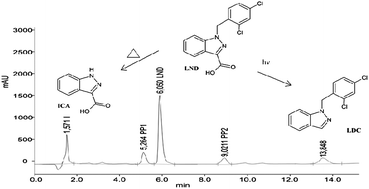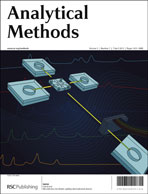A sensitive HPLC-DAD method for the simultaneous determination of the anticancer lonidamine and five potential impurities in pure powder and tablet dosage forms was developed and validated. The impurities comprised by-products from thermal and photodegradation and potential secondary products from the drug synthesis. The structure of the main drug impurity was elucidated with the aid of GC-MS chromatography. A good resolution of all the analytes was achieved on a Gemini C18 column using isocratic elution and DAD detection. The optimal mobile phase consisted of a mixture of methanol–phosphate buffer (pH 3) (80 : 20, v/v). At a flow rate of 1.5 ml min−1, the total time of analysis was less than 15 min. The method was determined to be linear in the range of 10–200 μg ml−1 for the quantitation of lonidamine and 0.5–50 μg ml−1 for the related substances with a detection limit of 0.15 μg ml−1 for the impurities. Percentage recoveries ranged from 97.4 to 102.3 and 95.7 to 103.5 for the drug and impurities, respectively, and the relative precision values were less than 3.3%. Finally, the method was demonstrated to be robust, resistant to small variations of chromatographic variables such as pH, mobile phase organic/aqueous composition and column temperature.

You have access to this article
 Please wait while we load your content...
Something went wrong. Try again?
Please wait while we load your content...
Something went wrong. Try again?


 Please wait while we load your content...
Please wait while we load your content...